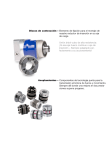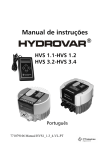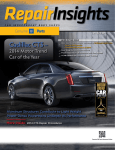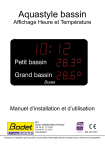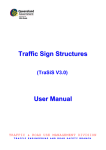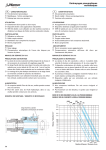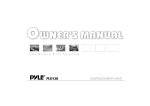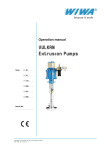Download inStallation and operating inStruCtionS For r+W
Transcript
inStallation and operating inStruCtionS For r+W torque liMiting CouplingS: SERIES SK general FunCtioning please carefully and completely read the following installation, operation and maintenance procedures for the r+W torque limiting couplings. Failure to comply with these procedures may result in poor performance and/ or the failure of the coupling. Installation of the couplings should be performed by a qualified technician. tranSport r+W couplings are delivered ready for installation. after incoming inspection the coupling should be stored in its original packaging until it is ready for installation. a copy of this installation, operation and maintenance manual should be kept with the coupling. SaFetY alert rotating couplings can be very dangerous. proper guarding should be in place at all times and is the responsibility of the machine builder, user or operator. do not approach or touch a coupling while it is rotating. Make sure that the machine is „locked out” and cannot be accidentally started during installation or maintenance of the coupling. ManuFaCturer’S deClaration according to EG guidelines for machinery 2006/42/EG Appendix IIB. in the sense of machine guidelines (Mr) shaft couplings are no machines, but components for the installation in machines. their putting into operation is subject to the fulfillment of all requirements of machine guidelines by or after integration in the final product. general FunCtioning r+W torque limiting couplings are ball detent style overload couplings. they protect drive and driven mechanical components from damage associated with torque overloads. Backlash free torque transmission is accomplished by a series of steel balls (4) nested in hardened detents (5). See figure 1. disc springs push against an actuation ring (3) keeping the balls nested. the disengagement torque is adjustable by means of an adjustment ring (1). in the event of an overload, the actuation ring moves axially allowing the balls to come of the detents separating the drive and driven elements. the movement of the actuation ring can be sensed by means of a mechanical switch or proximity sensor triggering the drive to shut down. Single-poSition / Multi-poSition Full-diSengage Figure 1 Figure 2 actuation path (d) engaged disengaged in a torque overload, for the single-position design (standard) and multi-position design, the spring disengages to allow the balls to come out of their detents separating the drive and driven elements. very low residual spring pressure remains so that the coupling will re-engage once the torque is reduced below the overload setting. See diagram 1 too. Re-engagement may only be effected at low speed. Re-engagement: Full disengagement the r+W torque limiter can be re-engaged with a low engagement force e (table 2) on six positions within a 360° circle. the markings of the re-engagement positions had to be lined up. Starting on series 60, the re-engagement can be done with 2 levers, which must be strutted on the adjustment nut. also two screwdrivers can be used as levers. (see pic. 3b) Important: Re-engagement must happen on shutdown only. rW-CouplingS.CoM engaged disengaged With this design, when a torque overload is detected, the disc spring completely flips over and places no residual spring pressure on the actuation ring. the drive and driven elements are completely separated. Re-engagement of the coupling is not automatic and must be performed manually (Figure 3). recess on the adjustment nut engagement force (e) lever (screwdriver) Figure 3a Figure 3b 1 Mounting preparation recommended to ease the mounting process and will not affect the clamping force of the hub. All mounting surfaces including shafts, bores, keys, and key ways, must be clean and free of burrs, nicks, or dents. Inspect shaft diameters; coupling bore diameters, key and key-way dimensions and tolerances. All R+W coupling bores are machined to ISO tolerance H7. Clearances between shaft and hub bores are maintained to 0.01 and 0.05 mm. A light coating of oil is CAUTION: Do not use sliding grease, or oils and grease with molybdenum disulfide or other highpressure additives. Mounting drive elements to SK 1/SKP/SKN couplings + tightening torque SK complete SERIES 1,5 Belt pre-tensioning force max. (N) Distance from - to (mm) Fastening screws ISO 4762 Clamping hub Tightening torque (Nm) Fastening screws ISO 4762 Clamping hub SKN Tightening torque Clamping hub SKN (Nm) Fastening screws ISO 4762 Tapered bushing Tightening torque Tapered bushing SKN (Nm) B Distance from - to F max. (A) Figure 4 A B 25 3-6 2 4,5 10 15 30 60 50 100 300 700 900 1100 5-8 6-11 6-14 7-17 10-24 10-24 M2,5 M3 80/150 1500 10-24 200 300 500 800 1500 2500 1700 2200 2800 4000 5000 7000 12-26 12-28 16-38 16-42 20-50 28-60 M4 M4 M5 M6 M8 M10 M12 M12 M16 2xM16 2xM20 x 1 2 4 4,5 8 15 40 70 120 130 200 250 470 x x x x x M5 M6 M8 M10 M12 M12 M14 M16 M20 x x x x x 8 15 40 70 120 130 210 270 500 x x x x x M4 M5 M5 M6 M6 M8 M8 M10 M12 M16 x x x x 4 6 8 12 14 18 25 40 70 120 Additional bearing Figure 5 Table 1 Mounting of the drive element: Center the drive element (i.e. timing belt pulley or gear) onto the connecting flange of the coupling and fasten with screws. If the center of the radial load falls over the middle of the coupling an additional support bearing is not required (figure 4). If the radial load is not centered over the coupling an additional support bearing is required (figure 5). Please observe the maximum allowable radial load for each coupling size as indicated (Table 1). Excess radial load will affect the performance of the coupling. Mounting and dismounting: Models SKP / SK1 / SKN SKP with key Figure 6 Endplate SK1 / SKN with clamping hub SK1 Series 1,5 - 10 SKN Series 15 - 2500 Figure 7 Clamping screw P SK1 with tapered bushing Series 15 - 2500 Clamping screw N removal jack srew Figure 8 Mounting: Slide the coupling onto the shaft. Lock it in position, with an end plate (8) for example. Figure 6. Dismounting: Remove the end plate and slide the coupling off the shaft using an appropriate tool. Mounting: Slide the coupling onto the shaft to the proper axial position. Using a torque wrench tighten the clamp screw (P) to the proper tightening torque as indicated in Table 1. Dismounting: Simply loosen the clamp screw (P) and remove the coupling. Mounting: Slide the coupling onto the shaft to the proper axial position. Using a torque wrench, uniformly tighten the clamping screws (N) using a cross-wise tightening pattern until all the clamping screws are evenly tightened to the correct tightening torque as given in Table 1. While tightening the coupling may move slightly towards the tapered bushing. CAUTION: Further tightening of the clamping screws may destroy the tapered bushing connection. Prior to reassembly make sure that the jack-screws are raised to their original position. Dismounting: Loosen the clamping screw (N). Insert the three jack screws into the taped holes on the tapered segment apply even pressure to remove the tapered segment. Remove the coupling. 2 rw-couplings.com Mounting and diSMounting SK2 / SK3 / SK5 SK2 with clamping hub Mounting: prior to mounting make sure that the shaft to be connected do not exceed the angular or lateral misalignment limits for the coupling size to be used. this data can be found in the catalog. Slide the coupling on the first shaft end to the proper axial position. using a torque wrench, tighten the clamp screw to the correct tightening torque as indicated in table 1. insert the second shaft into the other end of the coupling to the proper axial position. Make sure that the coupling is free of any axial forces before tightening. tighten the clamp screw as above using a torque wrench. Dismounting: Simply loosen the clamp screw and remove the coupling. Figure 9 SK3 with tapered bushing Mounting: prior to mounting make sure that the shaft to be connected do not exceed the angular or lateral misalignment limits for the coupling size to be used. this data can be found in the catalog. Slide the coupling onto the first shaft to the proper axial position. using a torque wrench, uniformly tighten the clamping screws using a cross-wise tightening pattern until all the clamping screws are evenly tightened to the correct tightening torque as given in table 1. CAUTION: Further tightening of the clamp screws may destroy the tapered bushing connection. Dismounting: loosen the clamping screws. use the three jackscrews conveniently mounted in the taper segment to evenly back out the tapered segment. remove the coupling. Figure 10 CAUTION: Prior to reassembly make sure that the jackscrews are raised to their original position. SK5 with press-fit tapered bushings C Mounting: prior to mounting it is necessary to consider the overall length of the assembled coupling. the press-fit coupling requires a specific pre-tensioning (C) between the two coupling halves to ensure backlash free operation. Mount the „female” coupling half containing the bellow onto the first shaft end to the proper axial position. using a torque wrench tighten the clamp screw to the proper tightening torque. Mount the „male” coupling segment onto the second shaft end. the proper axial position is when the two couplings come together and coupling is compressed by the proper pre-tension distance (C ). See table 2. When the coupling segment is properly positioned tighten the clamp screw to the proper torque. Dismounting: pull the coupling apart. Simply loosen the clamp screws and remove the coupling from the shaft. pre-tensioning Figure 11 aXial MiSalignMent R+W bellows couplings compensate for lateral, axial and angular misalignment simultaneously. Maximum shaft misalignment in addition to torque overload protection r+W torque limiters combined with a metal bellow compensate for lateral, axial and angular misalignment. table 2 contains the maximum allowable values for each axis of misalignment for the different size couplings. it is important to remain within these limits to ensure maximum life and proper operation of the coupling. lateral misalignment ∆ Kr axial misalignment ∆ Ka angular misalignment ∆ Kw CAUTION: Exact alignment of the R+W metal bellow coupling considerably increases the service life of the coupling. Reducing or eliminating lateral misalignment eliminates the radial loading of the adjacent bearings, increasing service life and reducing heat. For drives running at high speed it is recommended to align the coupling with a dial indicator. Figure 12 SERIES 800 1500 2500 lateral misalignment x/x (mm) ∆ Kr 0.15/0.20 0.15/0.20 0.20/0.25 0.20/0.30 0.15/0.20 0.20/0.25 0.20/0.25 0.20/0.25 0.25/0.30 0.25/0.30 0.30/0.35 1,5 2 4,5 10 15 30 60 80/150 200 300 500 0.35 0.35 0.4 axial misalignment x/x (mm) ∆ Ka 1/1.5 1/2 1/2 1/2 1/2 1/2 1.5/2 2/3 2/3 2.5/3.5 2.5/3.5 3.5 3.5 4 angular misalignment x/x (degree) ∆ Kw 1/1.5 1/1.5 1/1.5 1/1.5 1/1.5 1/1.5 1/1.5 1/1.5 1.5/2 1.5/2 2/2.5 2.5 2.5 2.5 1-2.5 pre-tensioning (mm) C 0.1-0.5 0.2-0.7 0.2-0.7 0.2-1.0 0.2-1.0 0.3-1.5 0.5-1.5 0.5-1.0 x 0.5-1.5 0.5-2.0 0.8-2.0 0.8-2.2 actuation path (mm) d 0.7 0.8 0.8 1.2 1.5 1.5 1.7 1.9 2.2 2.2 22 2.2 3 3 20003000 30004000 engagement force approx. (full disengage design) table 2 (n) e 5-10 8-15 10-20 15-30 20-40 25-50 40-80 50-100 80-150 100-220 250-700 800-1200 x/x First values are for bellows with 4-5 currigations. Second values are for bellows with 6-8 currigations. rW-CouplingS.CoM 3 eMergenCY SWitCH FunCtion Mechanical switch (Order No. 618.6740.644) distance TECHNICAL DATA SK, ES2, SL Max. Voltage Max. Permanent current Protection type Type of contact Ambient temperature Confirmation 250 v aC Proximity switch (Order No. 650.2703.001) M 12x1 10 a max. 2 ip 65 opener -30° to +80° C (metal) actuation path SWITCH SYMBOL TECHNICAL DATA SK, ES2 Voltage range: Initial current max. Switch frequency: Temperature range Protection type Switching type Switch distance: 10 to 30 v dC 200 ma 800 Hz -25°C to +70°C ip 67 pnp opener max. 2 mm SWITCH SYMBOL Figure 13 Figure 14 the axial movement of the actuation ring (3) can be sensed be either a mechanical switch or a proximity sensor. the distance the actuation ring moves is given in table 2 and is important for the selection of the appropriate sensing devise. Mount the sensing devise on a solid support keeping the distance shown in figure 13+14. Without prior agreement it is not allowed to operate r+W torque limiters of the series SK and eS without end switch. in case of a eletronic circuit collapse, the coupling had to be checked visually right after the first disengagement for the preassigned disengagement torque. Here fore the marks on the adjustment nut are the reference value. Note! Test the switch prior to the delivery of a machine using this devise. diSengageMent torque Setting Figure 15 view Figure 16 Spanner wrench for din 1816 nut 1 11 3 12 13 positive stop adjusting nut fastening screw steel actuation ring adjustment range marking With SK 2/5 couplings the groove of the clamping hub serves as a marking (3) The adjustment range may not be left during setting. adjustment range actuation path tKn max to adjust the disengagement torque, loosen the locking screws (11) and rotate the adjustment ring using a spanner wrench to the desired new setting. tighten the locking screws and test the coupling. CAUTION: R+W torque limiters incorporate disc springs that exhibit a special spring characteristic. It is important to stay in the max-min range of the courding. bei tKn min Spring force r+W torque limiters are factory set to the customer specified disengagement torque, which is marked onto the coupling. the adjustment range (min/max) is also marked on the adjustment ring. the customer can adjust the disengagement torque as long as it falls into the range indicated on the adjustment ring. tKn min diagram 1 spring path MaintenanCe CAUTION: Disassembly of the coupling will void the warranty. R+W Antriebselemente GmbH alexander-Wiegand-Str. 8 · 63911 Klingenberg phone +49 9372 9864-0 · Fax +49 9372 9864-20 [email protected] · www.rw-couplings.com 4 the above-mentioned information is based on our present knowledge and experiences and does not free the user of his own regular checks. a legally binding guarantee is not given even in regard to protection rights of third parties. rW-CouplingS.CoM 11/2014/2500 r+W torque limiters are maintenance free as long as they are properly mounted and the maximum misalignment and radial load values are not exceeded. the internal components are permanently greased for lifetime lubrication.




